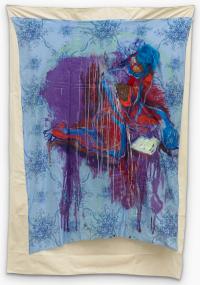Works


Installation Views
Press Release
For Gupuro, her third solo exhibition at Jan Kaps, Kresiah Mukwazhi brings together two of her well-known series: new works painted on fabric and works made from repurposed bra straps. Although the two bodies of works each have their own esthetic, they are conceptually, materially and anecdotally aligned. With this exhibition, the artist continues her exploration of the role of women and critically engages with traditions, forms and economies that have traditionally disenfranchised sections of society, particularly women, in her home country of Zimbabwe and around the world. In many ways, the exhibition talks about making and breaking connections, the tying and untying of knots. In the culture of the Shona, the largest ethnic group in Zimbabwe, the Gupuro is a symbolic act that formally ends a marriage or partnership: A token of separation is presented to signal the release from the marriage. This act goes beyond the act of separation; it carries cultural weight and means that the person can now move on without social or spiritual barriers, although it was often only initiated by the husband. Traditionally, only men gave the token of separation, as they were the ones that paid the lobola or bride price. Beyond a formal divorce or separation, Gupuro is seen as a spiritual release, a way of severing spiritual ties and obligations that have arisen during their time together. This is important because, according to Shona belief, relationships bind not only the couple but also their ancestors. Severing these ties requires a spiritual act to ensure harmony between the living and spiritual worlds. When a union ends, the Gupuro serves as a means of cleansing and restoring balance. Kresiah Mukwazhi recently went through a separation herself. “I gave myself permission,” she says, “to rediscover, renew and revive my sense of self.” In many of her works and in her artistic approach in general, the artist focuses on how to use challenging experiences, such as coming to terms with a relationship ending, as a springboard to self-empowerment and healing. “I gave my then lover a pebble for Gupuro—white stone painted sky blue”. The artist wrapped the pebble in an envelope, which in Indian culture is used by women to pay their dowry and on which images of flamingo birds in a paradisiacal forest were printed: “I have created the inversion of what my culture tells me what I should and should not do as a woman”. For the exhibition, Kresiah Mukwazhi abstracted the symbol of the pink bird—with its connotations of stability and grace—and used it as the basis for a larger-than-life installation in two of the gallery spaces, with one of the walls framing a self-portrait of the artist writing a letter. She painted it on a fabric used in the manufacture of mattresses, a material that speaks of intimate memories and the intertwining of souls through the act of love. Her second series, made from used bra straps, continues the literal and figurative weaving and stitching together of materials and symbols that are shipped across continents and whose status as objects shifts from fast fashion to charity donations to resale items, representing the bodily constriction and objectification of millions and millions of women. The exhibition Gupuro coincides with the ongoing presentation of Kresiah Mukwazhi’s monumental bra strap mural at Museum Ludwig in Cologne, which is part of the fourth iteration of the Schultze Projects curated by Yilmaz Dziewior.
Ultimately, Kresiah Mukwazhi sees Gupuro as an attempt to alchemize the old into the new, to transform what has been into a foundation for what is to come, and in particular to change the perception of what the institution of marriage means to women and what purpose it serves in a woman’s life, no matter where.
















